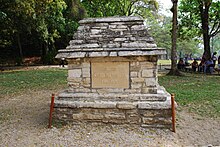Alberto Ruz Lhuillier
Alberto Ruz Lhuillier | |
|---|---|
 | |
| Born | 27 January 1906 |
| Died | 25 August 1979 (aged 73) Montreal, Quebec, Canada |
| Occupation | archaeologist |
Alberto Ruz Lhuillier (27 January 1906 – 25 August 1979) was a Mexican archaeologist. He specialized in pre-Columbian Mesoamerican archaeology and is well known for leading the National Institute of Anthropology and History (INAH) excavations at the Maya site of Palenque, where he found the tomb of the Maya ruler, Pakal. Ruz Lhuillier is sometimes referred to as the "Hitchcock of Archaeology".[1]
Early life[]
Ruz Lhuillier was born in Paris, France to a Cuban father and a French mother.[1] He went to college in Havana, Cuba, where he learned about the impact of American interference in Cuban affairs and he became deeply involved in the socialist revolution to oust Cuba’s US puppet dictators and to free his country from ‘yanqui’ imperialism. In addition, these early student life experiences exposed him to other students who espoused the theories and ideas of Karl Marx. Later Ruz would use some of these theories to explain the development and fall of ancient Maya civilization.[2] He moved to Mexico in 1936, later acquiring Mexican citizenship.
Career[]
After the unexpected death of Miguel Ángel Fernández in 1945, Ruz Lhuillier took charge of the INAH's investigations at Palenque. While he served as the INAH's southern Director of Pre-Hispanic Monuments, Ruz Lhuillier excavated much of the city and restored and conserved such edifices as the Palace. In 1948, he discovered the entrance to the tomb of the Maya ruler, K'inich Janaab' Pakal, hidden beneath the Temple of the Inscriptions. After four seasons of clearing the rubble-filled stairway, he found Pakal's sarcophagus and body.[3][4] Ruz Lhuillier's team also found the Tablet of the Palace, which served as the back to a throne, and the Tablet of the Slaves which depicts a cahal amid bound captives. Ruz Lhuillier continued working at the site until 1958.
Ruz Lhuillier died in Montreal, Quebec, Canada on 25 August 1979.[5] Several of his books on the Maya, including Los Antiguos Mayas, were published posthumously.
Honoring his works, the Mexican Government permits that his remains rest in peace in front of the Necropolis that was discovered by him at the Maya site of Palenque, Chiapas.
Works[]
- Los Antiguos Mayas, Una Antologia (English: The Ancient Maya: An Anthology) - (January 1981)
- El Pueblo Maya (English: The Maya People) - (January 1982)
- Frente Al Pasado De Los Mayas (English: Facing the Past of the Maya) - (January 1987)
- El Templo De Las Inscripciones, Palenque (English: The Temple of the Inscriptions) - (January 1992)
- Palenque 1947-1958 - (January 2007)
References[]
- ^ Jump up to: a b Bertrán, Antonio (June 2002). "Alberto Ruz Lhullier: The 'Hitchock of Archaeology'". Reforma (in Spanish).
- ^ Schele, Elaine Day (2012). "Profile of Alberto Ruz Lhuillier as a Young Man". Bulletin of the History of Archaeology. 22 (2): 4–11. doi:10.5334/bha.22202.
- ^ Mathews, Peter (2007). Palenque: recent investigations at the classic Maya center. Rowman Altamira. p. 4. ISBN 978-0-7591-0875-2.
- ^ Veber, May. "Pyramids in the Americas." The World's Last Mysteries. Pleasantville, NY: Reader's Digest Association, 1978. 180-187. Google Books. ISBN 0-89577-044-X. Retrieved February 10, 2016.
- ^ Stuart, George E.; Gene S. Stuart (1977). The Mysterious Maya. National Geographic Society. p. 77.
Alberto Ruz — whose own death came on August 25, 1979...
External links[]
- Works by or about Alberto Ruz Lhuillier in libraries (WorldCat catalog)
- Fotobiografía de Alberto Ruz Lhuillier short biography in Spanish with many photos
- 1906 births
- 1979 deaths
- Mayanists
- Mexican Mesoamericanists
- Mesoamerican archaeologists
- Mexican archaeologists
- Mexican people of Cuban descent
- French emigrants to Mexico
- 20th-century Mesoamericanists
- People from Paris
- 20th-century archaeologists